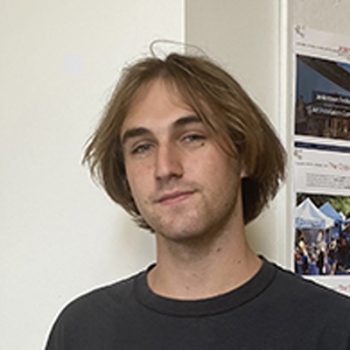Livingstone Undergraduate Research Award in Creative Works and Media Production
Livingstone Undergraduate Research Award in Creative Works and Media Production
Russell Berg

Complex Resonance: Complementary Contrast in the Works of Mitchell/Giurgola and Venturi Scott Brown and Associates
View Russell’s project online
I wrote a comparative research paper focused on two prominent architectural firms from the second half of the 20th century which were based in Philadelphia, in which I looked at an art museum renovation/addition completed by each firm as my point of reference and analysis. The impetus to conduct such a project was to take a closer look at some of the divergent ways in which architects pushed away from the dominant forces of Modernism which had been prevalent before the conclusion of WWII. The firms of my comparison adopted notably different paths from each other and away from the Modernism of the first half of the 20th century, however, their focus and drives were often in agreement and took similar forms in many respects.
What is your major and expected year of graduation?
I am a historic preservation major and philosophy minor, graduating in the fall of 2024.
What inspired you to pursue your project?
First of all, I found my architectural history courses taught by Professor Stephen Anderson to be of great interest and relevance in understanding the background which contemporary architecture draws from. More specifically, in the spring of 2023 I found myself intrigued by the writings of the French philosopher (and briefly practicing architect) Paul Virilio, from which I began to view the striking and heavy-handed architecture of the 20th century in a new light. It was at the recommendation of Professor Anderson that I conducted my summer 2024 CARAS grant research on the Philadelphia architect Romaldo Giurgola and his firm, and then this research happened to coincide quite well with Professor Pablo Meninato’s Movements in Modern Architecture course the following semester. It was in Professor Meninato’s course that I developed the present work which I submitted for the Livingstone Award.
What does winning this award mean to you?
At perhaps the most obvious level, winning this award means receiving recognition for the time and effort I put into my research projects. I certainly spent much of the last few years in the Charles Library (perhaps more than I should have), and I am grateful that a good portion of that time was spent crafting a project which I feel has underpinned my time as an undergraduate student. Winning this award feels like confirmation that confusion and frustration are appropriate ways to feel as a student, so long as these feelings are channeled into some cohesive project.
How did the Libraries support your research?
My research could not have happened without the support of the Temple Libraries. Most of the material that drove my project was found either at the Charles Library itself or within the vast resources available online. From helpful Library staff to the troves of databases which I had access to as a student, the library was present in most, if not all, steps of my research.
Russell Berg’s essay examines the work and ideas of two of Philadelphia’s most influential architectural studios in the second half of the 20th century, Mitchell/Giurgola (centering on partner Romaldo Giurgola) and the partnership of Robert Venturi and Denise Scott Brown. Their presence falls within what is referred to as the “Philadelphia School,” a period that spans the 1960s and 1980s—a moment that marked a crucial transition from the “heroic” phase of the Modern Movement to the beginnings of Postmodernism, positioning Philadelphia as a critical ground for architectural debate. Both firms represent divergent yet influential architectural trends. While Romaldo Giurgola incorporates forms and gestures that echo historical forms (with clear resonances from his native Italy), his position suggests the possibility of continuation of the modern project. In contrast, Venturi and Scott Brown advance a radical criticism of modern architecture and urbanism; their approach is characterized by a deep engagement with theoretical, artistic, and social considerations, as exemplified in their seminal books Complexity and Contradiction in Architecture and Learning from Las Vegas. By examining the works and ideas of Mitchell/Giurgola and Venturi & Scott Brown, Russell’s essay offers a valuable perspective on Philadelphia’s architectural developments during the second half of the 20th century.
—Pablo Meninato, Associate Professor, Tyler School of Art and Architecture
This category covers research which culminates in a creative or multimedia work in areas such as Visual Arts, Music, Dance, Theater, or Media Production.
This award is generously sponsored by John H. Livingstone, SBM ’49.
